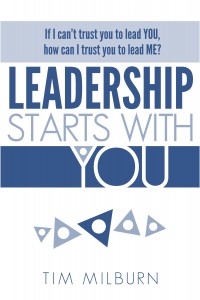//NOTE: The following is an excerpt from my book, Leadership Starts With You.
Leaders can’t take an interest in growing others if they choose to take an intermission in growing themselves.
Growing old doesn’t take a lot of work. You can grow old without even thinking about it. Unfortunately, maturity doesn’t come with birthdays.
Learning doesn’t happen naturally like aging. Learning takes work. The disciplined kind of work we’ve been talking about. People want to follow someone who is self-disciplined, not someone who is self-destructive. This is why leaders must be learners.

Consider what motivates you to learn and grow. Growing up, you were forced to learn in school. Teachers and tests made us learn something. Some of us did better with books, others with hands-on interaction. Some subjects sparked our interest. In others, we muddled through, hoping for a passing grade. In school, much of the motivation to learn comes from outside ourselves – from our teachers. Some teachers are better motivators than others. But there comes a point when you realize that you are the one who is ultimately responsible for your learning. It’s not a question of having teachers, it’s a matter of being teachable.
Just because teaching is taking place doesn’t mean learning is happening as well. Teachers have a responsibility to teach. You, as a student, have a responsibility to learn. If you’re going to grow, you have to take responsibility for it. As a keeper of the The Rhodium Rule (Do unto yourself what will inspire the best in others), your motivation to learn is fueled by your desire to lead. Leaders are learners.
One of the promises you must make to yourself as a leader is that you will stay invested in your learning – the kind of learning that leads to growth. You keep that promise to yourself by taking charge when it comes to your own growth.
Without the structure of an educational system, some leaders lack the ability to identify opportunities to learn and grow. I propose two simple strategies to assist with this process. You can measure and motivate your own growth by…
1. Looking back, and
2. Planning ahead
Start by looking back. Take some time to think about your answers to the following questions:
• What were you like a year ago?
• Are you the same person you were then?
• Are you still dealing with the same issues?
• Are you still trying to recover from the same mistakes?
• How many books have you read over the last year?
• How many seminars, conferences, and training events have you attended?
• Do you know any new skills?
• Are your relationships better or worse?
• Have you made any new friends?
• Are you in better or worse shape physically?
Looking back gives you perspective on your personal growth. You can learn a lot from the past if you’re willing to take a look at it, reflect on it, evaluate it, and learn from it. Hindsight has something to teach us. Looking at our past shows us why our present is better or worse than it was, say, a year ago. Evaluating the past is helpful. Living in the past isn’t healthy. Like driving a car, the rear view mirror is a useful tool, but you can’t move forward in your vehicle if you’re fixated on it. The windshield is a lot bigger than the rear view mirror for a reason. When it comes to growth, our past may show us where we’ve been, but it doesn’t have to determine where we want to go.
In the next post (Part 2), I’ll discuss why looking back is a good perspective, but planning ahead is a better perspective.
____________________________
 Interested in discovering simple and practical ways to grow yourself as a leader? Download my latest book, Leadership Starts With You. This book will assist you in developing your own self-leadership skills. It’s available for both the Kindle and the Nook. Visit leadershipstartswithyou.com to take the next step in leading yourself well.
Interested in discovering simple and practical ways to grow yourself as a leader? Download my latest book, Leadership Starts With You. This book will assist you in developing your own self-leadership skills. It’s available for both the Kindle and the Nook. Visit leadershipstartswithyou.com to take the next step in leading yourself well.
Share this Post
